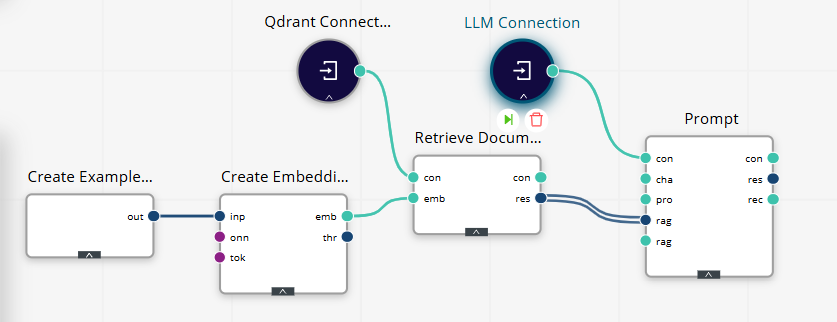Retrieval Augmented Generation
Retrieval-Augmented Generation (RAG) is an AI pattern that combines information retrieval with text generation to produce more accurate, contextually relevant, and up-to-date responses. Unlike standard Large Language Models (LLMs) that rely solely on their training data, RAG augments them with an external knowledge source—such as a database, vector store, or document repository—at query time. This ensures responses are grounded in factual, current, and domain-specific information.
Usefulness of RAG
- Improved Accuracy – Reduces hallucinations by grounding outputs in real documents.
- Domain Adaptability – Allows LLMs to work with organization-specific or proprietary knowledge without retraining.
- Freshness – Incorporates recent data without the need to re-train models.
- Explainability – Provides references to source documents for transparency.
- Efficiency – Eliminates the need to fine-tune large models for small updates.
Core Concepts (at a glance)
- Documents & Chunking - Long documents are split into chunks (e.g., 800–1,000 characters with 100–200 overlap) to improve recall and ranking.
- Embeddings - Text is converted to high-dimensional vectors; similar meanings imply nearby vectors.
- Vector Store - A database that stores embeddings and supports fast similarity search.
- Retriever - Given a user query (also embedded), finds the top-k most similar chunks.
- Prompt Construction - Retrieved chunks + instructions form the LLM prompt.
- Generation & Citation - LLM produces an answer and (ideally) references the retrieved sources.
RAG extension in AI Cloud
The RAG Extension brings retrieval directly into your Altair AI Cloud workflows. It lets you connect LLM-powered operators to external knowledge with minimal glue code.
Vector Stores
- Supported: Qdrant.
- Connection: Provide host/URL, port, API key, and TLS settings. Save as a reusable Connection in AI Cloud.
Embeddings
- Built-in models: Altair AI Cloud includes pre-built embedding models for common use cases.
- Custom models: You can register custom ONNX embedding models to meet domain or compliance needs.
The RAG extension provides different operators to create a collection, delete a collection, retrieve and insert data from the vector stores.

| Operator | Purpose |
|---|---|
| Create Collection | Create a new collection (index) in Qdrant. |
| Delete Collection | Drop an existing collection. |
| Insert Documents | Upsert vectors + payloads into a collection. |
| Retrieve Documents | Similarity search with configurable top-k and score threshold. |
| Create Embeddings | Convert text columns (and queries) into vector columns. |
Examples
Ingestion workflow
To better understand how to build RAG pipelines, let’s run through an example workflow for inserting the data into a vector store. See the workflow example below:

-
Read source content.
Use Read Document to load a PDF (or other files) → a table/ExampleSet with a text column.
-
Chunk/Split (optional but recommended).
If your document is long, split text into chunks (size ~800–1,000 chars; overlap 100–200).
-
Embed.
Apply Create Embeddings on the text (or chunk) column using your selected embedding model to create an IOObject.
-
Insert.
Use Insert Documents to upsert vectors into the vector store.
Retrieval-and-Generation Workflow

-
Create the query.
Use Create ExampleSet with a single row/column query (e.g., “Summarize refund policy deadlines.”).
-
Embed the query.
Apply Create Embeddings using the same embedding model as indexing.
-
Retrieve.
Call Retrieve Documents on your collection. Configure the number of results (start with 5–8).
-
Prompt the LLM.
Use Prompt to compose the system/user instructions and inject retrieved chunks.